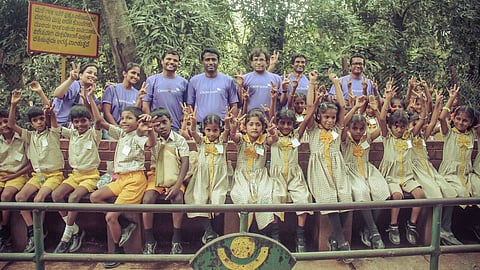Guided offline approach to learning
Equipping students with relevant knowledge and skills has a catalytic impact on eradicating poverty, reducing social inequalities, improving health, and driving economic growth. Without access to quality and relevant education, young people cannot build the skills needed to succeed in life and work. This failure, in turn, puts all the other SDGs at risk.
One marker of the challenges of the education system is the “Learning Poverty” (LP) index, defined by the World Bank as the inability to read and understand a simple text by the age of 10. More than half of the late primary age students in India do not have this reading proficiency. This is an early warning for an incompetent work force in the future.
Covid-19 has exacerbated the education crisis and has further increased the learning gap. Online classes were particularly ineffective for first generation learners with little support at home. There was an urgent need to experiment with, prove and establish an alternative scheme to provide quality education for all, in a cost-effective manner.
A pilot at the grassroots level: Sai Krushna Vidya Mandir (SKVM) is a high school located in Hosadoddi village about 20 km south of Bengaluru. This English medium school offers free education upto grade 10 to children in nearby villages, whose parents are mostly farmers/household workers. Most of the children in the school are first generation school goers. The school proved to be an ideal testing ground for the implementation of a novel scheme called Guided Offline Approach to Learning (GOAL).
Unlike online modes where the student needs net connectivity to attend live classes, the offline mode of GOAL is a synchronous, with the delivery of the learning materials decoupled from its consumption. The students can access the contents on their own schedule, without the need for net connectivity.
SKVM enlisted volunteers as Virtual Mentors (VM) for one-on-one coaching and mentoring for the students. These volunteers are spread out across the globe and sign up out of interest in mentoring the village children to enhance their school performance. It was also necessary to assess the students on a continuous basis. For this purpose, the students regularly took quizzes in the school with their tablets connected to a local Wi-Fi hotspot. A central team in the school analysed the responses and generated feedback.
This scheme was able to pinpoint and address specific weaknesses of each student. Once the learning gaps were identified, they were quickly remedied by VMs. The continuous process of evaluation and feedback and the short turnaround time is the lynchpin of the scheme.
Scaling up: To scale a GOAL-like programme, regular delivery of learning materials for offline use must be ensured for all along with local guidance for the study. An always-on satellite link can deliver the digital contents, including notes, just-in-time tips, and quizzes for assessment of learning. A GEO satellite-linked hotspot is quicker to establish, provides lower network congestion and fewer distractions compared to a web link. A local hotspot can provide the best content and methods to all without any geographical barrier.
Proven technology exists to provide this link by riding on an existing satellite transponder and receiving the spread spectrum signal 24x7 without even a dish antenna. For such a system the satellite receiver is so small that it can be housed inside a user tablet. This enables the student to have curated content on one’s personal device to be accessed anytime.
For guidance, one could employ and train facilitators as teaching assistants. This is superior to possibilities of machine learning to create Virtual AI tutors, as real mentors build lifelong relationships with the students, which also holds them accountable.
Looking ahead: The satellite-linked hotspot in every school and every community would allow caching of the learning materials for targeted transfer to student and teacher devices. For the early age learners, a satellite-linked tablet personal to them would help realise the objectives of NEP2020 to provide a flexible, multi-level, play/activity-based distraction-free learning. These technology-enabled methodologies, supplementary to classroom learning, will lower the Learning Poverty. Once they learn to read, they can read to learn.
With the recent opening of the space sector in India, the stage is set for private industry to provide these space-based services by setting up hotspots in every village. This is an extension of the concept of Village Resource Centres (VRC) that ISRO has already proven on ground. VRCs would also generate employment for local youth, as potential teacher assistants.
A satellite-linked VRC supports fulfillment of several other SDGs, like Health, Agriculture, Reduced Inequalities, Sustainable Communities and Partnerships. Corporates and NGOs could help establish and train the optimal use of such an infrastructure, benefitting different stakeholders.
When children do not have access to clean water and nutrition, they are physically stunted. Without access to quality education, the brain gets stunted. Similar to the Poshan Abhiyaan to improve nutrition, a national mission is needed to lay the foundation for quality education. This can be done by scaling up the GOAL concept with satellite-linked devices.

